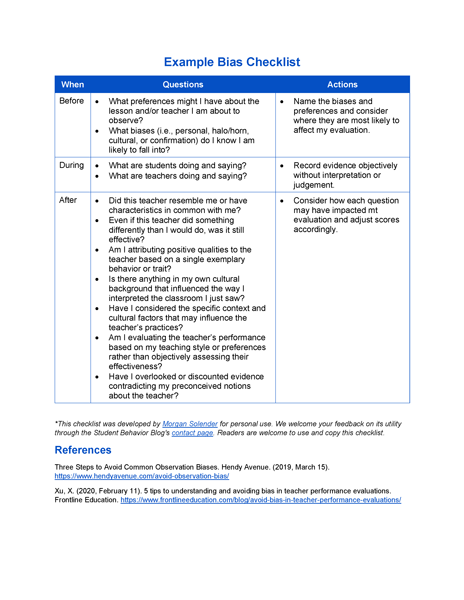
Classroom observations are a key tool in educational research and practice, used to evaluate teaching methods, assess student engagement and behavior, and gather data on classroom interactions to inform instructional strategies and policy decisions. However, observations are not immune to implicit biases—or attitudes, behaviors, and actions that are prejudiced in favor of or against one person or group compared to another. These biases can skew observers’ perceptions and lead to unfair evaluations, ultimately leading to unreliable and inaccurate conclusions that undermine the very support we aim to provide. In this blog, we identify the types of implicit bias that are most likely to impact the reliability of classroom observations and offer concrete strategies for minimizing the impact of these biases.
How do implicit biases impact classroom observations?
Implicit biases are shaped by our background, cultural environment, and personal experiences, subtly influencing how we perceive and interact with others. We all carry internal biases and are often unaware of them, as they operate below the surface.
When evaluating teacher practice, implicit biases can cloud objective observations. For example, one study showed that evaluators give higher ratings to teachers of the same race. In the same study, principals rated teachers they hired more favorably than otherwise-similar teachers.1 These biases, which have nothing to do with actual teacher practice, can lead to unfair consequences for teachers and misinformed decisions regarding their performance and development. In order to conduct fair and reliable observations, it’s essential for evaluators to set aside personal biases before conducting observations, ensuring a focus on objective teacher and student actions.
What types of bias might impact observations?
There are multiple types of implicit bias and it’s important to be aware of them to minimize their impact on objective observations.
| Bias Type | Example |
|---|---|
| Personal bias: Evaluators tend to give higher ratings to teachers who resemble them or have characteristics in common with them. Likewise, evaluators tend to give lower ratings to teachers who look and act differently than they do.2 | An evaluator who is an extrovert and enjoys interactive class discussions might rate an outgoing teacher more favorably, while giving lower ratings to an introverted teacher who prefers a quieter, structured classroom environment. |
| Halo and horn effect: A positive or negative trait shown early in an observation or in previous observations can influence subsequent ratings.3 In the halo effect, a teacher’s positive trait or behavior can overshadow other aspects of their performance, leading to an inflated overall observation. In the horn effect, one negative trait or behavior of the teacher influences the evaluator’s perception of their overall performance. | On the second day of observations, an observer might expect a teacher to receive high marks on classroom management if the teacher performed well the day before. Conversely, if a teacher performed poorly on classroom management the first day, the observer might deflate their subsequent ratings, despite improvements. |
| Cultural bias: Evaluators might implicitly judge a teacher’s performance based on cultural norms or expectations that may not be relevant or applicable to the specific context.4 | An evaluator who views individual work and teacher control as a sign of effective classroom management might give low scores to a teacher whose class is centered around lively, student-led class discussion. |
| Confirmation bias: Evaluators tend to search for or interpret information in a way that confirms their preconceptions.5 | An evaluator knows that a teacher has been coached to implement a new behavioral intervention and gives the teacher high marks following an observation, even though the teacher used several negative behavior management tactics. |
Avoiding implicit bias in classroom observations
To provide fair and reliable evaluations, it is crucial for researchers and practitioners to partake in ongoing reflection to recognize which biases they are most prone to and minimize these biases. Here, we suggest five strategies for avoiding implicit bias in classroom observations.
- Use standardized observation tools: When possible, employ standardized observation protocols —pre-defined, consistent measures that include a training protocol, parameters around observation, and scoring directions. Standardized tools help ensure that observations are consistent and objective across different classrooms because they provide a common framework and criteria for assessment.
- Participate in training on implicit bias: Participate in training sessions focused on recognizing and mitigating implicit biases. Training can help increase awareness of subconscious biases and provides strategies to manage them. It is important to note, there is limited empirical evidence supporting the efficacy of implicit bias trainings, particularly if these events are one-time, mandatory sessions. Despite these limitations, well-designed implicit bias trainings that include targeted, positive approaches and skill-building tasks have been shown to produce positive effects in some contexts.6
- Implement double coding: When possible, have two independent evaluators observe the same classroom session and separately record their assessments. Double coding allows for cross-checking and comparison of observations, helping to identify and mitigate individual biases through consensus and discussion.
- Create a bias checklist: Develop and use a checklist to remind yourself of potential biases and strategies to mitigate them before and after each observation. A checklist can serve as a practical tool to keep you vigilant and intentional about avoiding bias in your observations.6
- Engage in reflective practice: Keep a journal or discuss your observations with colleagues to reflect on and address your own biases. Reflective practice is crucial for personal growth and objectivity because it allows you to identify and correct your biases over time.7
Final Thoughts
Although we cannot be free of bias, if we can acknowledge and understand our biases, we will be better able to limit their effects. We hope this blog helps researchers and practitioners reflect on how their implicit biases may impact teacher observations and develop tools to ensure fair and reliable observations.
Resources
- Project Implicit: a free Implicit Association Test tool designed to measure the strength of associations between concepts or stereotypes to reveal your implicit or subconscious biases.
- Implicit Bias Awareness Training from the National Equity Project: a free, prerecorded webinar that focuses on understanding and addressing implicit bias within the context of historical and ongoing structural racism.
- Implicit Bias Module Series from the Kirwan Institute for the Study of Race & Ethnicity: a series of brief lessons, help you understand how our minds form implicit associations and provide strategies to recognize and mitigate your own biases. This series specifically focuses on the impact of implicit biases and racial disparities in education.
- Bias checklist: an example of a bias checklist that can be used before, during, and after a classroom observation to identify and avoid potential biases.
References
2 Eren, O. (2023). Potential in-group bias at work: Evidence from performance evaluations. Journal of Economic Behavior & Organization, 206, 296-312. https://doi.org/10.1016/j.jebo.2022.11.030
3 Noor, N., Beram, S., Yuet, F. K. C., Gengatharan, K., & Rasidi, M. S. M. (2023). Bias, Halo Effect and Horn Effect: A Systematic Literature. International Journal of Academic Research in Business & Social Sciences, 13(3), 1116 – 114. https://doi.org/10.6007/ijarbss/v13-i3/16733
4 Fan, Y., Shepherd, L. J., Slavich, E., Waters, D., Stone, M., Abel, R., & Johnston, E. L. (2019). Gender and cultural bias in student evaluations: Why representation matters. PloS one, 14(2). https://doi.org/10.1371/journal.pone.0209749
5 Khoujah, D. (2019). The Role of Bias in Performance Evaluations and Inclusion the Workplace. American Academy of Emergency Medicine. https://apps.aaem.org/UserFiles/file/CS_MarApr19_DI.pdf
6 National Institutes of Health. (2021). Scientific Workforce Diversity Seminar Series (SWDSS) Seminar Proceedings Is Implicit Bias Training Effective?. https://diversity.nih.gov/sites/default/files/media-files/documents/NIH_COSWD_SWDSS_Implicit_Bias_Proceedings_508.pdf
7 Shuck, V., Adams Salmela, J., Prinster, M., & Geisler, C. (2023). Self-reflection interventions for implicit gender bias reduction: Scoping the literature for a conceptual way forward. Journal of Human Behavior in the Social Environment, 1-24. https://doi.org/10.1080/10911359.2023.2212014
Topics: Educator professional development and support
Tags: Classroom Management Classroom Observations Implicit Bias Quality Rating and Improvements System Reflective practive Teacher evaluation

